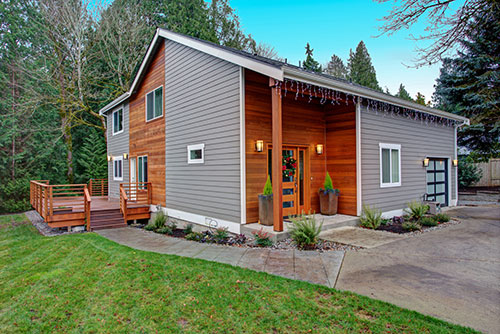A more distinctive exterior can increase buyer interest in your builds. From different types of wood siding to fiber cement, these relatively uncommon types of house exteriors will help you level-up a home’s aesthetics.
- Board and batten: Typically installed vertically, this type of exterior can make a home seem taller. It also allows for good creativity, since you can use boards of different length. The wood is easy to install and maintain. You can also choose from fir, pine, redwood, cedar, engineered wood and vinyl, which won’t rot and is resistant to pests.
- Log: Created with redwood, cypress, pine or cedar, log exteriors give homes a rustic aesthetic. To promote durability, the logs need to be dried and treated to prevent decay, insect infestation and cracking. While they can be stained or painted, a simple clear coat is generally preferred, since this creates a more natural appearance. At $3 to $8 per square foot, log exteriors do come with higher initial costs; however, they can really make a home stand out from the pack in the right market.
- Horizontal wood boarding: This type of exterior is created by placing thin wood strips horizontally, sometimes using tongue and groove. Whether you use spruce, pine, cypress or Douglas fir, the horizontal pattern helps to create a classic rustic look that can really enhance curb appeal. Initial costs can be high depending on the wood, and there is always a risk of rot, water and insect damage. That said, you can mitigate this by customizing the home with a quality paint or stain.
- Fiber cement: Comprised of a combination of cement, sand and wood fibers, this versatile material is created to mimic other materials, including natural wood. Fast becoming the top wood alternative in North America, fiber cement is available pre-painted or pre-coated. You can also get untreated material and paint or stain it after installation. In addition to its incredibly realistic look, fiber cement is resistant to insects, water and fire. It can also be manufactured in a diversity of colors, designs and textures, including stone or brick. On the downside, the material is quite heavy, resulting in increased installation costs. It’s also double the price of vinyl and not quite as durable as stone or brick.
- Insulated siding: An enhanced version of vinyl siding, this material includes an extra insulating layer of expanded polystyrene foam (EPS) that’s fused to the back of the siding. This creates a much snugger fit, while markedly improving insulation. This results in as much as a 20-percent improvement in energy consumption over traditional vinyl materials on the market. It also includes all the usually advantages of vinyl, including warranties of up to four decades.
- Engineered wood: Made to look almost exactly like actual wood, this type of siding is made of composite materials. Unlike fiber cement, however, engineered wood actually contains a good amount of natural wood, giving it a more authentic appearance. Not only is engineered wood much less expensive than natural wood, it can be customized in a variety of styles that mimic varying species and stains, along with an assortment of convincing textures. Engineered wood is also especially durable, lasting for two to three decades. It also holds up quite well to insects, fire, moisture and extreme weather.
Structural Warranties can protect builders and their buyers from devastating structural problems. Protect your business with 2-10 Structural Warranties today!








